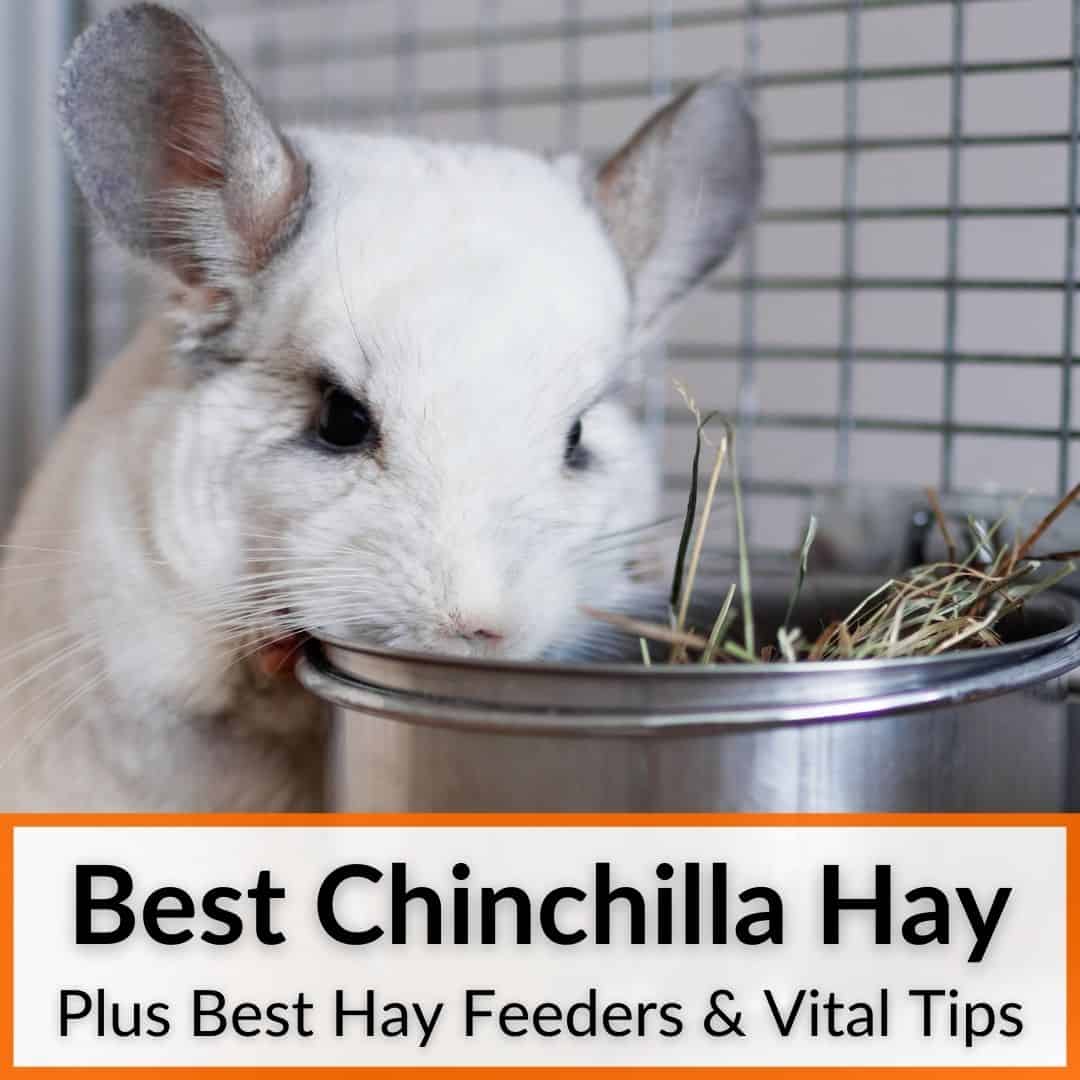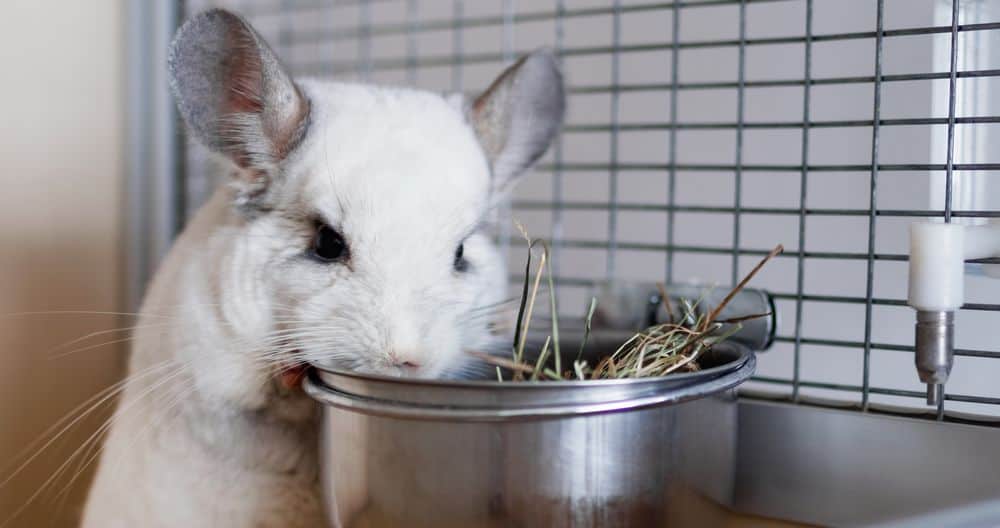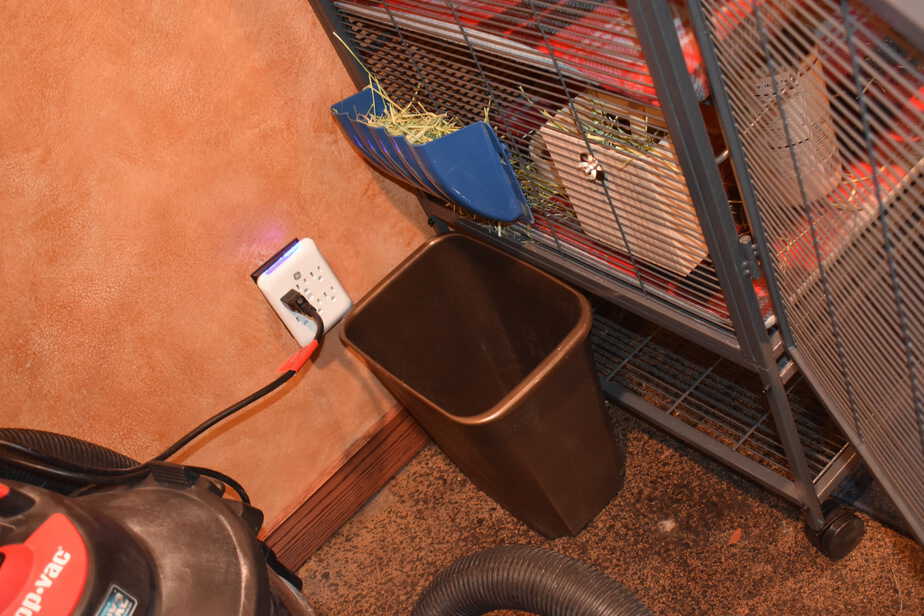
It should make up 80% to 90% of their diet to ensure their digestive, dental, and overall health.
But don’t just head out to a field and grab some hay.
The dangers of it containing pests, pesticides, or something else harmful to your chinchilla are far too great.
You need to buy specifically formulated hay for chinchillas.
The best chinchilla hay has high levels of protein and a balanced nutritional blend. And it is not expensive.
Keep reading for a comparison and reviews of the best hays for chinchillas on the market. We’ll also cover the best hay feeders and everything else you need to know about hay and your chinchilla.
Contents
Best Chinchilla Hay Compared
Those 4 recommendations are your best options as far as health, nutritional balance, and budget are concerned, when purchasing hay for your chinchilla.
Click any of the ‘check price’ buttons in the chart above to learn more about the hay blend.
I currently use the timothy hay cubes and the large bags of Timothy hay for my chinchilla.
However, I did run some trial and error and go through a bag of the orchard hay first, before discovering that my chinchilla enjoys the timothy hay more.
You may have to do the same if you are a new chinchilla owner.
It’s cheap enough that I don’t think an extra bag of hay is going to make or break your decision to adopt a chinchilla.
Let them decide which one they prefer, in order to promote them enjoying their healthy and balanced diet.
Why Chinchillas Need Hay
Hay plays a significant role in your chinchilla’s diet, and it’s imperative that it’s included.
In fact, it needs to be more than included. It should make up most of your chinchilla’s diet.
Hay provides a chinchilla with the nutrients needed to maintain strong dental health, physical health, and digestive health, in order that they can live long and healthy lives.
You must insure that your chinchilla cage always has a full hay feeder or unlimited access to hay.
Not doing so can result in costly vet bills, your chinchilla becoming ill, or at the very best, a poor and unbalanced diet for your new family member.
Let’s break down why hay is so imperative and beneficial for chinchillas to give you a full understanding. It really comes down to 3 primary benefits that hay provides.
Hay Promotes Dental Health For Chinchillas

Chinchillas are chewers. If there is one thing I’ve learned from owning a chinchilla, it is that they love to chew.
It’s part of the reason that you must ensure you protect play areas when your chinchilla is out of the cage. You want them to be 100% safe to ensure your pet doesn’t chew dangerous items such as cords and wires.
This is also known as chinchilla proofing a room.
The best thing about chinchilla hay?
It’s chewy. Especially if you go with more course hay such as orchard hay.
Chewing is how chins naturally help themselves file down their teeth. Overgrown teeth in chinchillas can cause serious health concerns and even lead to death due to starvation from lack of eating or from infections.
The stems inside of the hay help chinchillas get the necessary chewing and teeth filing they need daily. You can also use the timothy hay cubes to help with teeth filing even further.
The hay cubes are even more challenging to eat for chinchillas and require a bit more effort, so mixing these into the diet can also prove to be healthy and beneficial.
Not to mention, all chinchilla hay or chinchilla hay cubes are very cheap.
Hay Helps The Digestive System
I think we are all aware that fiber has a way of running its natural course and helping the human digestive system.
Well, the good news is that plenty of fiber presents itself within chinchilla hay, as well.
For a body so small and fragile, chinchillas can easily have upset stomachs or issues passing “gas”, so to speak.
Ensuring that your chinchilla has a large amount of hay present in its diet helps to ensure its digestive system is always functioning at peak levels.
Don’t worry, my friends. Feeding your chinchilla hay is not going to increase the amount it poops. The amount a chinchilla poops is already extremely frequent, and more hay will not make a difference.
Hay Is A Balanced Approach To Healthy And Long Lives
The third and common health benefit that hay offers to chinchillas is obvious. It’s necessary, imperative, and must be part of your chinchillas’ diet.
Some owners begin shying away from hay or getting too treat heavy or relying on chinchilla formulated pellets.
It’s not that this is going to reduce your chinchilla life by 10 years by any means, but including hay and making it the focal point of your pet’s diet should be your priority from day 1.
Getting Your Chinchilla To Eat Hay

I started this post by informing you that you may run into the issue where you have a picky chinchilla. It happened to me, and I’m sure it could quickly happen to you.
For example, my chinchilla absolutely despises oxbow and orchard hay by itself. I have no clue why, otherwise I’d fill you in.
However, a fresh stack of timothy hay in her hay feeders is usually gone within a few days. She eats it quickly and loves it.
If you run into this issue, do as I mentioned previously. Switch hays. Mix and match. I still mix and match hays from time to time, and she doesn’t seem to mind this.
I will combine two sets just to get her some balance and nutrients that both blends of hays have to offer.
You may also run into an issue where a younger or baby chinchilla will only eat oxford hay. This is also completely normal and nothing to worry about.
If you are offering the hay and paying attention to how your chinchilla responds, you will be in great shape.
How Much Hay Do Chinchillas Eat?
All chinchillas are going to be different, but on average, a chinchilla will consume about 2 tablespoons of hay per day.
I’m honestly not sure how you would even track this. I don’t track or measure this myself.
I simply ensure my chinchilla gets treats on occasion and sticks to hay and pellets for all meals, and everything has been just fine for me.
If your chinchilla eats a bit more or a bit less than this, I wouldn’t be overly concerned.
However, if your chinchilla isn’t eating any hay at all, it may be time to dive deeper into the issue and perhaps consult a vet qualified to work with exotic animals or chinchillas.
Almost Any Hay Will Get the Job Done
We have covered just about everything that needs to be covered thus far.
I do often see others ask about other common hay options such as alfalfa hay, oat hay, meadow hay, etc. Most of the time, it’s just chinchilla owners curious if they are safe and worth trying.
The best answer I can give you is this: chinchillas eat timothy hay and orchard hay with the most frequency, and they are the most recommended.
However, oat hay, or even meadow hay, is perfectly safe for your chinchilla, if you feel like mixing it up or trying new hay to gain your chinchilla’s approval or attention.
Like I stated previously, all chinchillas are different, and hay itself is the most beneficial and healthy portion of their diets.
Do what you can to stick to timothy hay or orchard hay, but if the situation calls for other measures or different hay, then go for it.
It’s not going to cause any harm and could spark more interest from your chinchilla to mix it up and try something new.
Can Chinchillas Have Alfalfa Hay?
Yes, chinchillas can have alfalfa hay, but only in moderation. It is perfectly safe and is also nutritious, but it contains a lot of calcium and protein. That is why Timothy hay is best, so go with that whenever possible. But alfalfa hay can be a nice additional treat, just not the primary hay.
Use A Reliable Hay Feeder And Holder
Well, we now know hay is essential. The next task on the list is setting up the hay feeder/hay rack neatly within your chinchilla cage to make it easily accessible, avoid a mess, and have it looking as decent as possible.
In comes a reliable hay feeder or hay holder. This may be referred to as a hay rack, hay feeder, or hay holder depending on where you are looking.
You are looking for something that easily fits inside of your chinchilla cage, or attaches to the outside of the cage.
These are relatively cheap purchases, and there is really no need to get overly fancy with it.
I currently use two hay racks/feeders attached to my chinchilla cage.
They simply attach on the outside of the cage, making it easy to place the hay within the cage, and the chinchilla pulls the hay through the bars to eat.
Sometimes you have a little bit of spillover, but for the most part, the cage remains relatively clean.
Best Chinchilla Hay Feeders Compared
Those are my recommendations for the best hay feeders to use for holding and attaching the hay to your chinchilla cage so they can easily access it.
I currently use two hay feeders on my Critter Nation 2 dual-level cage (See Review Here).
One of them is the Kaytee Natural Wooden Hay Manger. It looks nice, attaches in 10 seconds, and is one of the more budget-friendly options.
However, I have tried all three recommendations in my chart above and they all work great and are well worth the few dollars.
In fact, the one I am currently using is actually my least favorite of the three, though the difference is miniscule. In the end, the decision is up to you and will depend on your preferences.
Best Chinchilla Hay And Feeder: Final Thoughts
Hopefully, this article was useful to anyone needing the inside scoop on how to get started with a proper diet and the best chinchilla hay possible.
Owning a chinchilla is a fantastic experience, and they make for wonderful pets.
I recommend owning a chinchilla to anyone who is currently on the fence and can say with confidence that it’s a decision you won’t regret.
Just make sure to order yourself some hay before the day of the adoption! Best of luck on your new journey.
Share your thoughts on chinchilla hay.
What has been your chinchilla’s favorite hay? Do you have any further recommendations you can share with the readers?
Be sure to share your thoughts, concerns, and recommendations by dropping a comment below.
As always, Chili and I appreciate you stopping by and reading. Thanks again, and we will see you next time.







Eva Vollera says
Thank you again for posting this my chinchilla has a plastic hay feeder that she loves to jump on but I saw her gnawing on it the other day so I will change it out and put a flat hopping station there with her dual cage she has plenty of space and she loves it . My one big problem now is that she eats the paper in her poop box and she ate and rolled around in the training pellets so I don’t know what to use as substitute. Any ideas?
Josh says
I use fleece liners. You can read about them here: http://planetchinchilla.com/best-chinchilla-bedding/